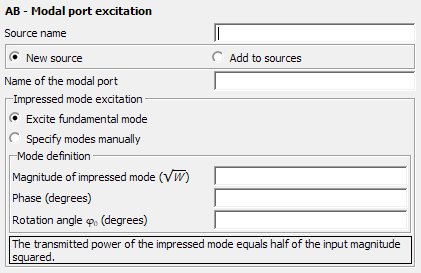AB Card
This card is used to create a FEM modal excitation, which is the fundamental mode of the associated, infinitely long guided wave structure of the modal port.
On the Source/Load tab, in the Sources on
geometry group, click the ![]() Modal source (AB) icon.
Modal source (AB) icon.

Parameters:
- New source
- A new excitation is defined which replaces all previously defined excitations.
- Add to sources
- A new excitation is defined which is added to the previously defined excitations.
- Name of the modal port
- Label of the modal port.
- Excite fundamental mode
- Select this option to automatically excite the fundamental mode of the waveguide. When this option is selected, the mode type and its indices ( and ) cannot be specified since they are determined automatically.
- Specify modes manually
-
- TE-mode
- If this option is checked, a mode (also referred to as ) is used as excitation. This option is only available when Excite fundamental mode has not been selected.
- TM-mode
- If this option is checked, a mode (also referred to as ) is used as excitation. This option is only available when Excite fundamental mode has not been selected.
- TEM-mode
- If this option is checked (only available for the coaxial waveguide since TEM modes don’t exist in rectangular/circular waveguides), a TEM mode is used as excitation. This option is only available when Excite fundamental mode has not been selected.
- Mode index m
- The index of the or mode which is impressed at the port. Note that for a rectangular waveguide the index m is related to the direction (for example from point S1 to S2). For a circular/coaxial waveguide, denotes the angular dependency. This option is only available when Excite fundamental mode has not been selected.
- Mode index n
- The index of the or mode which is impressed at the port. Note that for a rectangular waveguide the index is related to the direction (for example, from point S1 to S3). For a circular/coaxial waveguide, denotes the radial dependency. This option is only available when Excite fundamental mode has not been selected.
- Magnitude of impressed mode
- The magnitude of the impressed mode (absolute value of the complex amplitude of the
impressed mode). The transmitted power of the impressed mode equals half the input
amplitude squared.Note: If left empty or set to 0 then the modal port will act as a passive (sink) port for fields incident on the port.
- Phase (degrees)
- Phase of the impressed mode in degrees.
- Rotation angle (degrees)
- Rotation angle in degrees, applicable to circular and coaxial waveguide port shapes only. Specifies the rotation angle in degrees by which the impressed mode is rotated anti-clockwise with respect to the transverse reference axis.